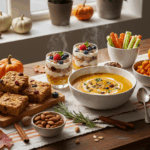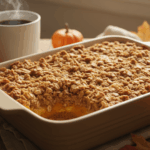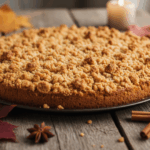Eating healthy dinners can be a key part of a successful weight loss plan. Many people struggle to find meals that are both tasty and good for them. This article offers seven simple and healthy dinner recipes designed to support weight loss without sacrificing flavor or satisfaction.
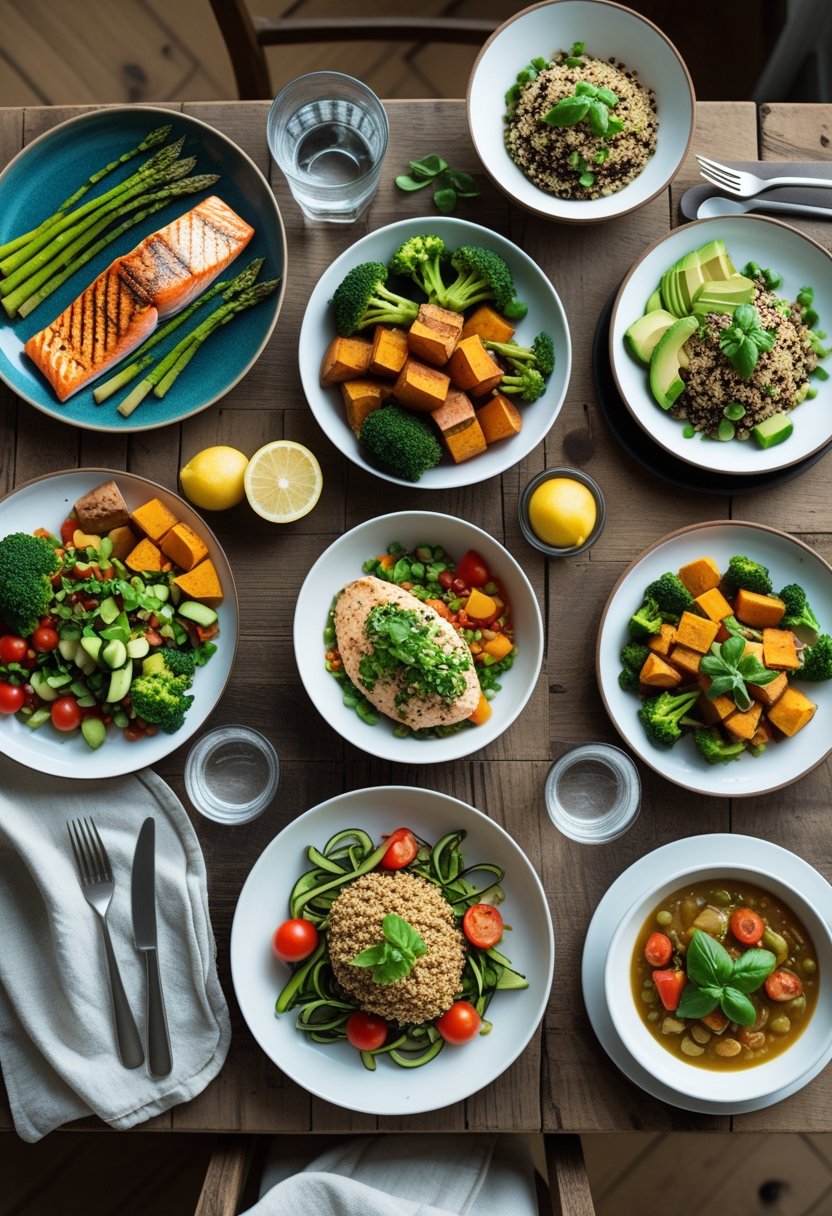
These recipes focus on balanced ingredients that help control calories while keeping meals filling. They are meant for those who want practical ways to eat better in the evening without spending too much time cooking or feeling hungry afterward.
1) Grilled Lemon Herb Salmon with Steamed Asparagus
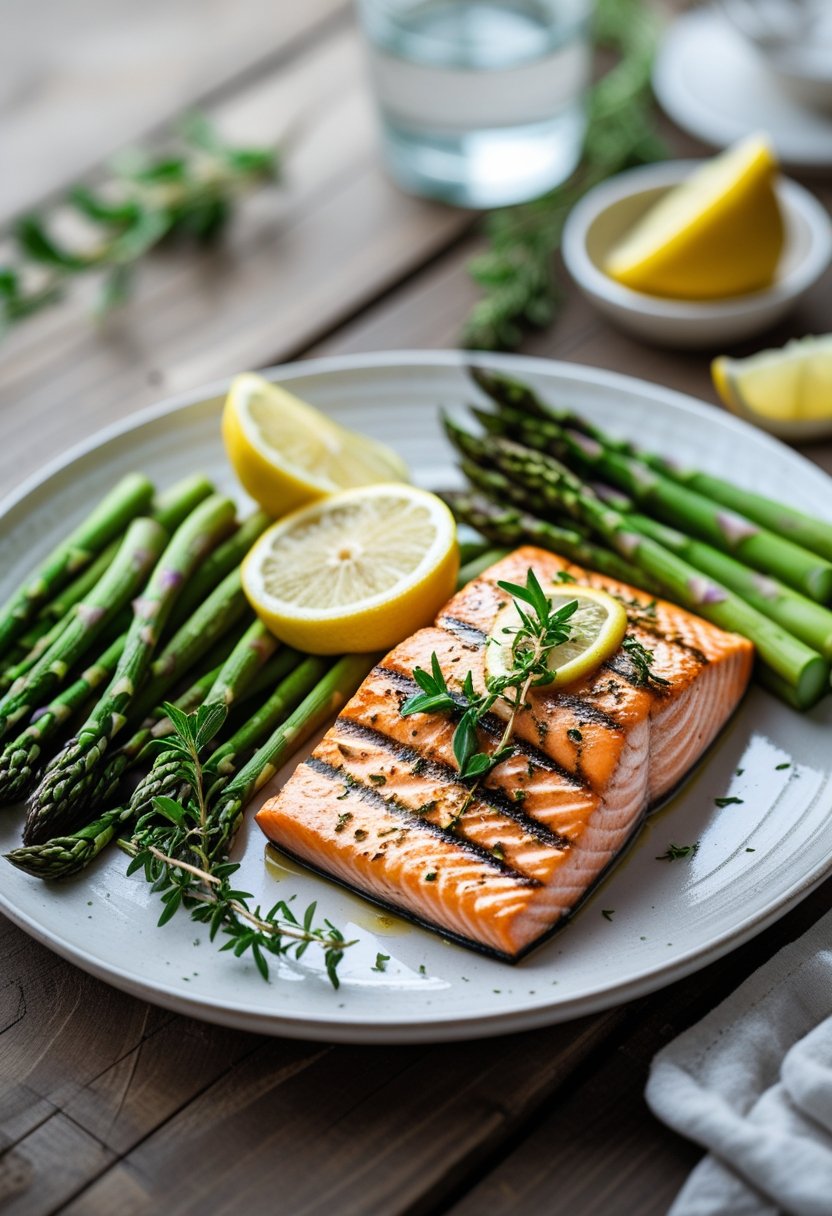
Grilled lemon herb salmon with steamed asparagus is a simple and healthy dinner option. This dish provides a good balance of protein from the salmon and fiber from the asparagus.
The salmon is flavored with fresh lemon juice and herbs, like dill or parsley, giving it a bright and fresh taste. The asparagus is lightly steamed to keep its crunch and nutrients.
This meal is low in calories and rich in omega-3 fatty acids, which support heart health. It cooks quickly, usually in under 30 minutes, making it suitable for busy evenings.
The ingredients are easy to find and require minimal preparation. Together, the salmon and asparagus create a light, satisfying dish that fits well into a weight loss plan.
2) Spicy Chickpea and Spinach Curry
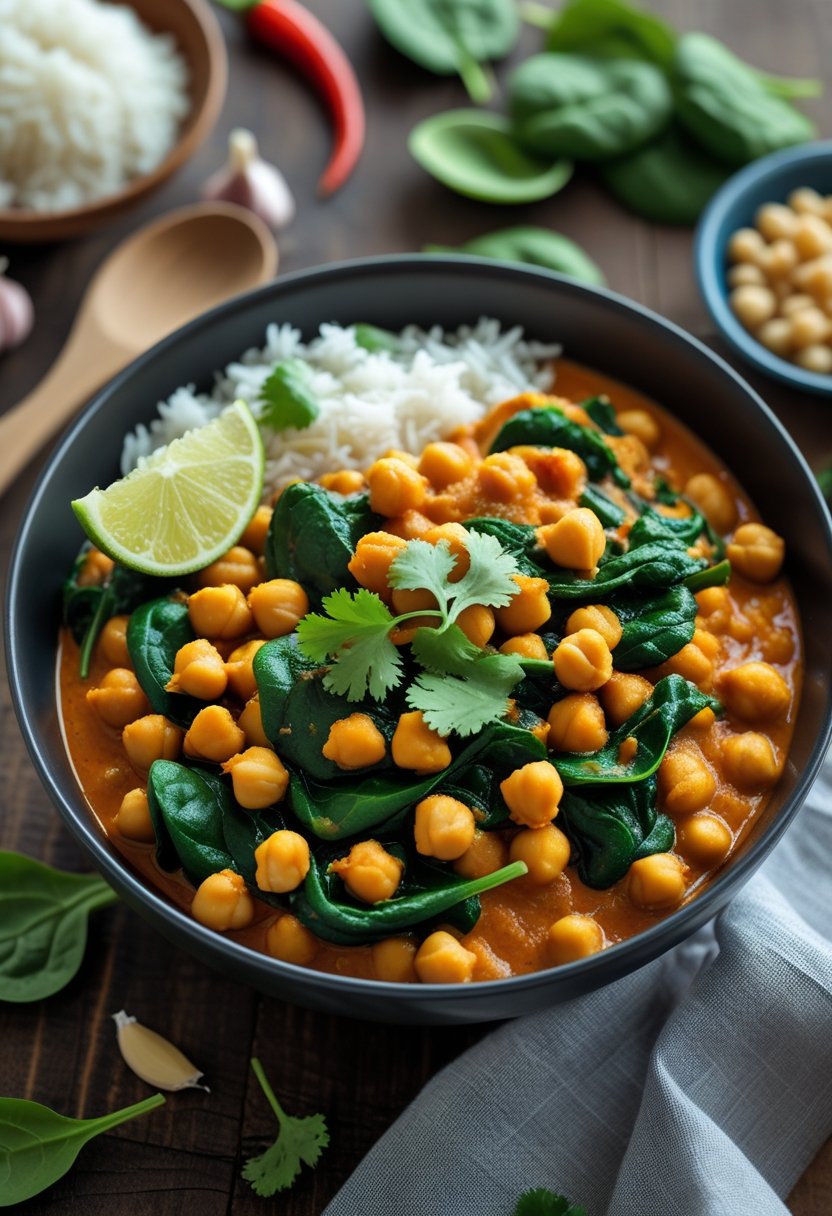
The spicy chickpea and spinach curry is a simple, nutritious dinner option. It combines protein-rich chickpeas with iron-packed spinach. This dish is both filling and light, making it good for weight loss.
The curry uses basic spices like cumin, turmeric, and chili to add flavor without extra calories. It cooks quickly, usually in about 30 minutes. The meal is also plant-based and low in fat.
This recipe can be made in one pot. It saves time and reduces cleanup. Using canned chickpeas and frozen spinach makes it even easier.
The curry is versatile. It can be served with rice or whole-grain bread. This meal supports a balanced diet and helps with managing weight when eaten as part of a healthy plan.
3) Baked Chicken Breast with Roasted Brussels Sprouts
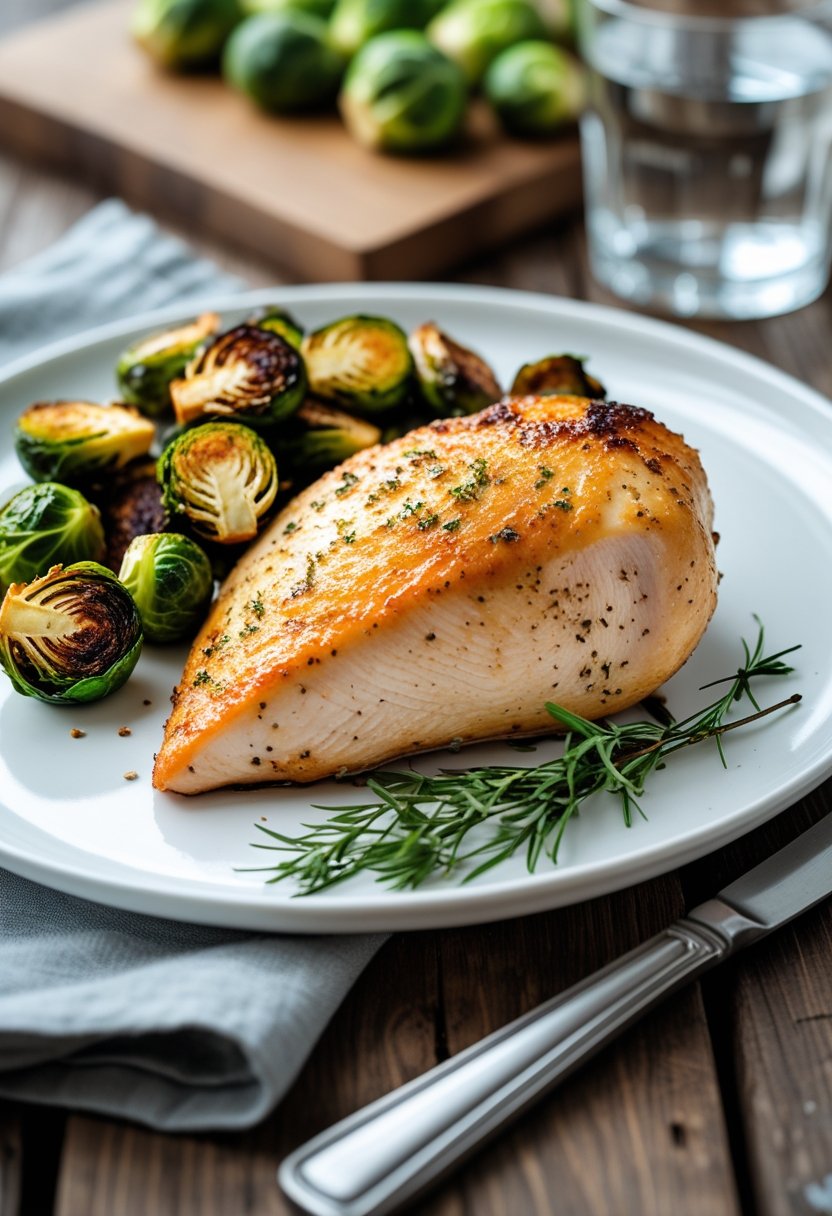
Baked chicken breast paired with roasted Brussels sprouts offers a simple, healthy dinner option. The chicken stays juicy when cooked properly, making it a good source of lean protein. Brussels sprouts add fiber and important vitamins, helping to keep the meal balanced.
This dish usually involves seasoning the chicken with spices like garlic, lemon, or mustard. The Brussels sprouts are tossed in a little olive oil and roasted until crispy. Cooking them together on one sheet pan saves time and reduces cleanup.
This meal is low in carbs and calories, which can support weight loss goals. The combination of protein and fiber helps with feeling full longer. It also offers a way to enjoy vegetables in a tasty, straightforward way.
4) Zucchini Noodle Stir-Fry with Tofu
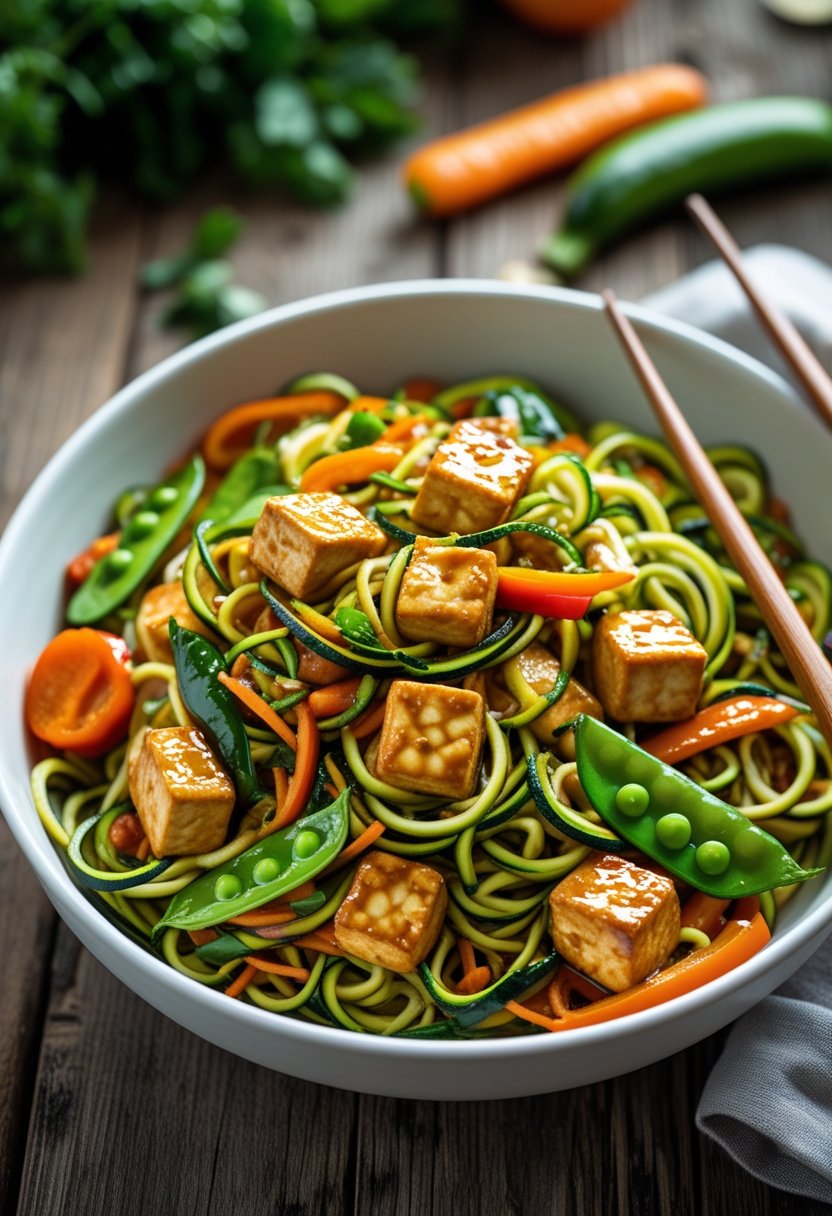
Zucchini noodle stir-fry with tofu is a light and healthy dinner option. It uses spiralized zucchini as a low-calorie alternative to traditional noodles. This meal is rich in protein from the tofu and packed with fresh vegetables like bell peppers and onions.
The dish is flavored with a simple soy-based sauce, often mixed with garlic, ginger, and a touch of sesame oil. It can be made quickly, usually in under 30 minutes, making it ideal for busy weeknights.
This stir-fry is low in carbs and sugar, which helps support weight loss goals. It is also rich in vitamins and minerals from the vegetables. Overall, zucchini noodle stir-fry with tofu offers a balanced, satisfying meal without heavy calories.
5) Quinoa Salad with Cucumber, Tomato, and Feta
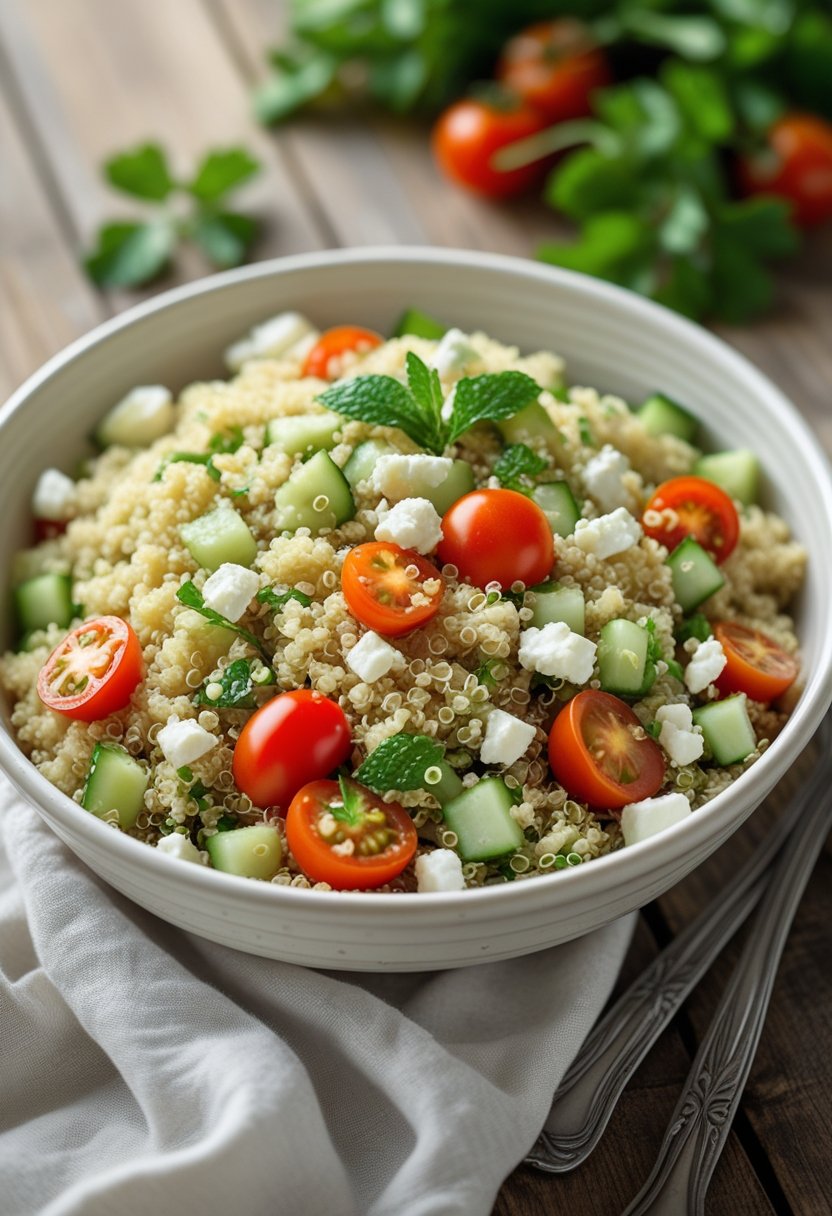
This quinoa salad is a healthy choice for dinner. It combines cooked quinoa with fresh cucumbers, ripe tomatoes, and creamy feta cheese. The salad is light but filling, making it suitable for weight loss.
The ingredients provide protein, fiber, and vitamins. Quinoa is a plant-based protein that supports muscle health and helps you feel full. Cucumbers and tomatoes add crunch and hydration with few calories.
Feta cheese adds flavor and some healthy fats. A simple dressing of olive oil and lemon juice or vinegar brings the salad together without adding too many calories. It can be served as a main dish or side.
This salad is easy to prepare and can be made in advance for meal prep. It is vegetarian and gluten-free, which works well for different diets. The fresh herbs like parsley or oregano can add extra taste without extra calories.
6) Turkey and Vegetable Lettuce Wraps

Turkey and vegetable lettuce wraps are a simple, healthy dinner choice. They use fresh lettuce leaves instead of bread or tortillas, which lowers calories and carbs. This makes them a good option for those trying to lose weight or eat gluten-free.
The filling usually includes lean ground turkey and a mix of chopped vegetables. Vegetables add fiber and vitamins while keeping the meal light. The ingredients cook quickly, making this dish perfect for busy weeknights.
These wraps are versatile and easy to customize. People can add spices or sauces for extra flavor without adding too many calories. They are also low-carb and high in protein, which helps with feeling full.
This meal works well as a main dish or a snack. It is quick to prepare, often ready in less than 30 minutes. Turkey and vegetable lettuce wraps offer a balanced and convenient way to eat healthy while supporting weight loss goals.
7) Eggplant Parmesan with Light Mozzarella
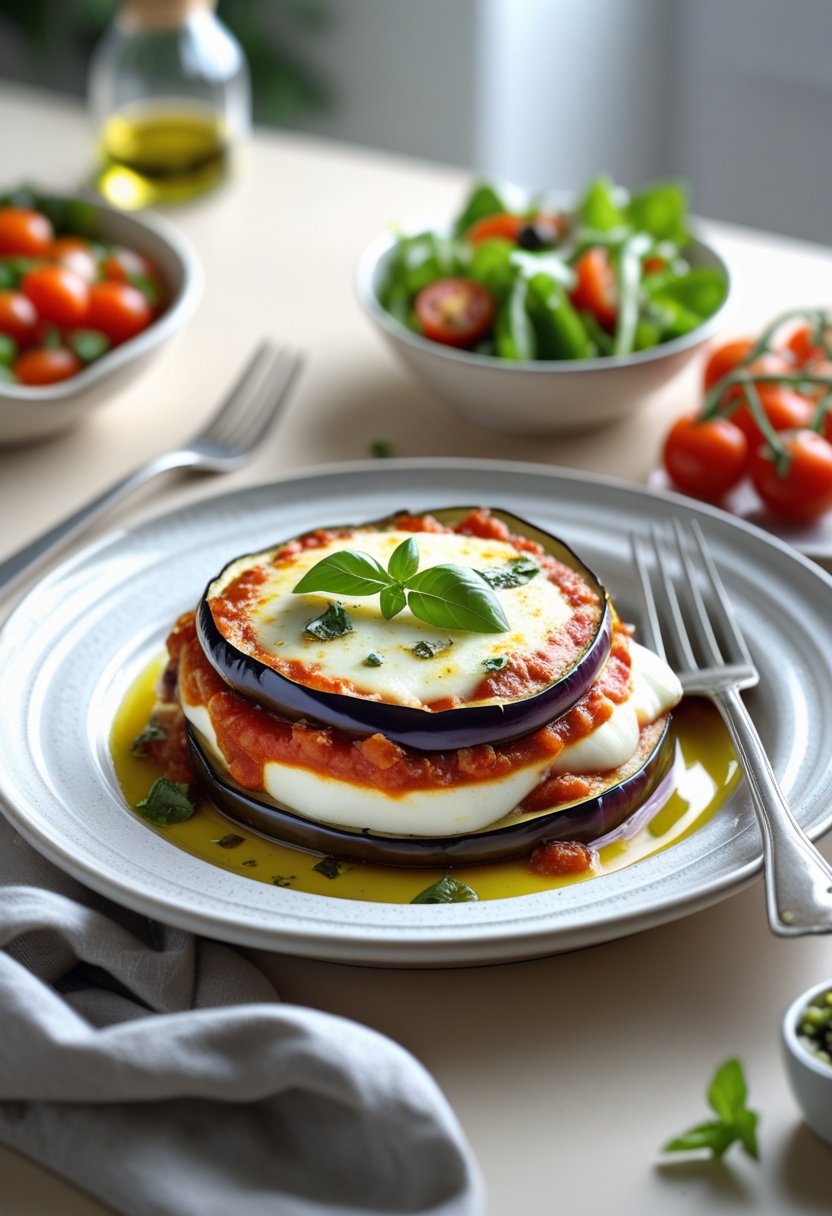
Eggplant Parmesan can be made healthier by using light mozzarella cheese and baking instead of frying. This reduces fat and calories while keeping the dish flavorful. Roasting the eggplant slices gives them a tender texture without the extra oil.
The recipe usually layers roasted eggplant with tomato sauce, light mozzarella, and a sprinkle of Parmesan cheese. This combination provides a good balance of taste and nutrition. Using lower-fat cheeses helps maintain the classic cheesy flavor.
This version of Eggplant Parmesan is suitable for those watching their calorie intake but still wanting a satisfying meal. It keeps much of the traditional taste while offering a lighter alternative. It can be served with a simple green salad or roasted vegetables to complete the dinner.
Nutritional Principles for Weight Loss Dinners
Effective weight loss dinners focus on managing calorie intake, balancing nutrients, and enhancing flavor without adding extra calories. These principles help maintain energy while supporting fat loss.
Portion Control Strategies
Controlling portion sizes is key to reducing calorie intake without feeling deprived. Using smaller plates and measuring food can prevent overeating. For example, a serving of cooked protein should be about the size of a deck of cards.
Visual guides are helpful:
- ½ plate for non-starchy vegetables
- ¼ plate for lean protein
- ¼ plate for whole grains or starchy vegetables
Eating slowly also helps. It gives the brain time to register fullness and reduces the chance of eating too much.
Balancing Macronutrients
A good weight loss dinner balances protein, carbs, and fats to support metabolism and keep hunger at bay. Protein should be a priority, as it helps preserve muscle and promotes fullness.
Carbohydrates should mainly come from fiber-rich vegetables and whole grains, which slow digestion and control blood sugar. Healthy fats, like olive oil or avocado, provide essential nutrients and help with nutrient absorption.
A typical breakdown might be:
- 30–40% protein
- 30–40% carbohydrates
- 20–30% fats
This balance supports energy and keeps meals satisfying.
Low-Calorie Flavor Enhancers
Adding flavor to meals without extra calories makes it easier to stick to a healthy plan. Herbs, spices, and citrus juices add taste without fat or sugar. Examples include garlic, ginger, basil, lemon zest, and black pepper.
Using cooking methods like grilling, roasting, or steaming can also enhance flavors naturally. Avoid heavy sauces or dressings high in sugar and fat. Instead, opt for light vinaigrettes or broths.
These simple swaps keep dinners enjoyable and nutritious.
Common Mistakes When Cooking for Weight Loss
Many people trying to lose weight make mistakes that slow down their progress. These include using too many calories in sauces, cutting out good fats, and depending too much on processed foods. Avoiding these errors helps keep meals both healthy and satisfying.
Overusing High-Calorie Sauces
High-calorie sauces can add a lot of hidden calories to meals. Many sauces contain sugar, cream, or oils that increase the calorie count quickly. Even small amounts can add hundreds of calories, which can counteract weight loss efforts.
People should measure sauce portions carefully or choose lighter alternatives. For example, tomato-based sauces or salsa often have fewer calories than creamy or sugary options. Using herbs, spices, or lemon juice can add flavor without extra calories. Paying attention to labels helps avoid sauces with added sugars or unhealthy fats.
Skipping Healthy Fats
Cutting out fats completely is a common mistake when trying to lose weight. Healthy fats from sources like avocados, nuts, and olive oil support brain function and keep people full longer. Ignoring these fats can lead to hunger and overeating later.
Including moderate amounts of healthy fats in meals helps balance nutrition. For example, a small handful of nuts or a drizzle of olive oil on vegetables adds essential nutrients. It’s important to avoid trans fats and limit saturated fats but not cut out all fats entirely.
Relying on Processed Ingredients
Processed foods often contain extra salt, sugar, and unhealthy fats. They are also usually lower in fiber and nutrients. Relying on convenience products can make meals less healthy and increase cravings.
Cooking with whole, fresh ingredients offers better nutrition and controls calorie intake. Using fresh vegetables, lean proteins, and whole grains helps keep meals balanced. Avoiding pre-packaged sauces, mixes, and ready meals reduces unnecessary additives and calories.
Frequently Asked Questions
Healthy dinners for weight loss often focus on lean proteins, vegetables, and whole grains. Meals that are simple, affordable, and filling tend to work best for long-term success. It is also important to choose recipes that support specific goals like reducing belly fat or fitting into stricter plans.
What are some simple recipes for healthy dinners that aid in weight loss?
Simple recipes include grilled lemon herb salmon with steamed asparagus and baked chicken breast with roasted Brussels sprouts. These meals require minimal ingredients but provide enough protein and fiber to stay full.
Can you recommend budget-friendly healthy dinner options for shedding pounds?
Budget-friendly options include spicy chickpea and spinach curry or quinoa salad with cucumber, tomato, and feta. These dishes use affordable ingredients and are easy to prepare in large batches.
What are the best dinners to eat for losing belly fat?
Meals with lean protein and vegetables, like zucchini noodle stir-fry with tofu, help reduce belly fat. Avoid heavy sauces and focus on low-calorie, nutrient-dense foods that support metabolism.
Could you suggest some filling yet healthy meal ideas that support weight loss?
High-protein meals like grilled salmon or baked chicken paired with roasted vegetables provide lasting fullness. Adding fiber-rich vegetables or whole grains helps prevent hunger after dinner.
Are there any dinner recipes that cater to extreme weight loss plans?
For more extreme plans, dinners under 500 calories, such as the spicy chickpea curry or quinoa salad, are suitable. Portion control and nutrient balance remain important to avoid nutrient deficiencies.
What healthy dinner choices can help maintain a balanced diet throughout weight loss?
Balanced dinners combine protein, carbohydrates, and healthy fats. Examples include grilled salmon with asparagus and quinoa salad with feta, as they provide essential nutrients and support steady weight loss.
